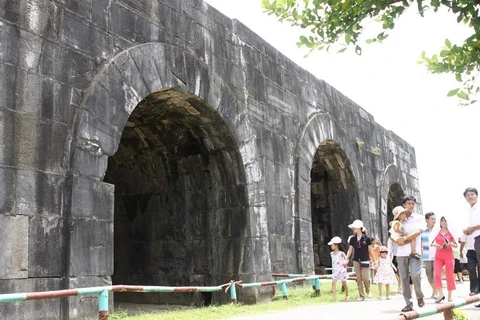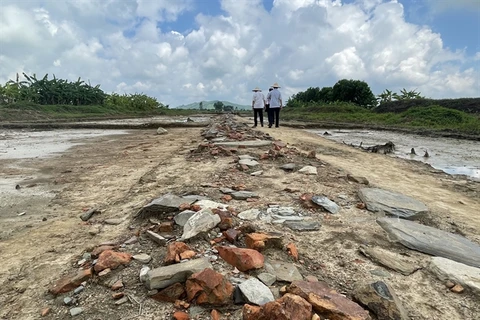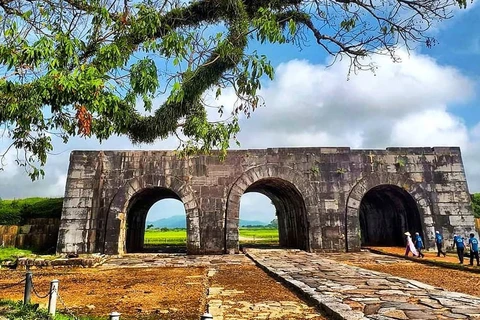Thanh Hoa (VNA) – The Institute of Archaeology and the Centre for Conservation of World Heritage Citadel of the Ho Dynasty held a conference on March 4 to report preliminary findings of excavation of four gates of the citadel.
The Citadel of the Ho Dynasty was built in 1397 as the capital of Dai Ngu (the name of Vietnam at that time), now Vinh Loc district, the central province of Thanh Hoa. It is unique for its outstanding construction technique which used large rock slabs, weighing from 10 to 26 tonnes each, carefully shaped, interlocked and elevated to an altitude of about 10 metres.
The citadel served as a military stronghold to protect the country from invasion, thus becoming a symbol of patriotism and national pride, and a witness of Vietnamese history during the late 14th and early 15th century. For the past six centuries, however, the forces of nature took its toll on the site. It was recognised by UNESCO as a World Cultural Heritage in 2011.
Recently, excavations have been conducted on a total area of 5,000 sq.m, including 2,000 sq.m each at the northern and southern gates, and 500 sq.m each at the eastern and western gates, and the Royal Path of the citadel.
Excavation efforts initially identified the appearance of the world cultural heritage at the gate and wall areas. The overall architecture of the Ho Dynasty Citadel is distributed into many horizontal and vertical layers, all of which are symmetrical about the Royal Path. The structure of the three walls on the East, South, and West are similar in size and slab interlocking techniques. Meanwhile, the stone layers in the wall and the northern gate are smaller in size, with larger joints, and there are also more rows of stones.
The excavation clearly revealed the vestiges of the Royal Path in the inner part of the citadel with traces of green stone embankment and slate at the middle of the southern gate.
Traces of a road with one 4.65m-wide lane and a 16m-wide lane have been unearthed.
The recent excavation also found some types of rectangular bricks decorated with leaf pattens from the Tran - Ho dynasties, flat tiles and gray curved tiles in the Le dynasty, and ceramic pieces from these dynasties./.
The Citadel of the Ho Dynasty was built in 1397 as the capital of Dai Ngu (the name of Vietnam at that time), now Vinh Loc district, the central province of Thanh Hoa. It is unique for its outstanding construction technique which used large rock slabs, weighing from 10 to 26 tonnes each, carefully shaped, interlocked and elevated to an altitude of about 10 metres.
The citadel served as a military stronghold to protect the country from invasion, thus becoming a symbol of patriotism and national pride, and a witness of Vietnamese history during the late 14th and early 15th century. For the past six centuries, however, the forces of nature took its toll on the site. It was recognised by UNESCO as a World Cultural Heritage in 2011.
Recently, excavations have been conducted on a total area of 5,000 sq.m, including 2,000 sq.m each at the northern and southern gates, and 500 sq.m each at the eastern and western gates, and the Royal Path of the citadel.
Excavation efforts initially identified the appearance of the world cultural heritage at the gate and wall areas. The overall architecture of the Ho Dynasty Citadel is distributed into many horizontal and vertical layers, all of which are symmetrical about the Royal Path. The structure of the three walls on the East, South, and West are similar in size and slab interlocking techniques. Meanwhile, the stone layers in the wall and the northern gate are smaller in size, with larger joints, and there are also more rows of stones.
The excavation clearly revealed the vestiges of the Royal Path in the inner part of the citadel with traces of green stone embankment and slate at the middle of the southern gate.
Traces of a road with one 4.65m-wide lane and a 16m-wide lane have been unearthed.
The recent excavation also found some types of rectangular bricks decorated with leaf pattens from the Tran - Ho dynasties, flat tiles and gray curved tiles in the Le dynasty, and ceramic pieces from these dynasties./.
VNA
























